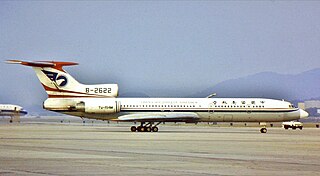
The Airline of the Islamic Republic of Iran, branded as Iran Air, is the flag carrier of Iran, which is headquartered at Mehrabad Airport in Tehran. As of 2023, it operates scheduled services to 72 destinations in Asia and Europe. Iran Air's main bases are Imam Khomeini International Airport and Mehrabad International Airport, both serving Tehran, the capital of Iran. Domestically, Iran Air is commonly known as Homa, which is the name of a mythical Persian phoenix or griffin, and also the acronym of Iran National Airlines in the Persian language. The airline's cargo division, Iran Air Cargo, operates scheduled services internationally using one cargo aircraft.

The Tupolev Tu-154 is a three-engined, medium-range, narrow-body airliner designed in the mid-1960s and manufactured by Tupolev. A workhorse of Soviet and (subsequently) Russian airlines for several decades, it carried half of all passengers flown by Aeroflot and its subsidiaries, remaining the standard domestic-route airliner of Russia and former Soviet states until the mid-2000s. It was exported to 17 non-Russian airlines and used as a head-of-state transport by the air forces of several countries.
This is a list of aviation-related events from 1993.
Qeshm Air is an Iranian airline; it has its headquarters in Tehran, Iran and operates scheduled domestic and international passenger services as well as charter flights. The airline was founded in 1993 as Faraz Qeshm Airline.

Caspian Airlines is an airline headquartered in Tehran, Iran. Established in 1993, it operates services between Tehran and other major cities in Iran and international flights to Turkey and Iraq. Its main base is Mehrabad International Airport, Tehran.

Mehrabad Airport, is an airport serving Tehran, the capital city of Iran. Prior to the construction of the larger Imam Khomeini International Airport in 2007, Mehrabad was Tehran's primary airport in both international and domestic traffic, but now serves only domestic flights. Despite this, in 2016, Mehrabad Airport was the busiest airport in Iran in terms of passengers, handling 16,678,351 passengers in total. The airport is also used by the Government of Iran and is one of the bases of the Iranian Air Force.

Isfahan Shahid Beheshti International Airport is an international airport serving the city of Isfahan, Iran.

Mashhad International Airport is an international airport located in Mashhad, Razavi Khorasan, Iran.
Abadan International Airport is situated 12 kilometers away from the city of Abadan, Iran.

China Southwest Airlines Flight 4509 (SZ4509) was a domestic flight in China from Chengdu Shuangliu International Airport, Sichuan to Wenzhou Yongqiang Airport, Zhejiang. On February 24, 1999, the Tupolev Tu-154M operating the flight crashed while on approach to Wenzhou Airport, killing all 61 passengers and crew members on board.

Baikal Airlines Flight 130 was a scheduled domestic passenger flight from Irkutsk to Moscow that crashed on 3 January 1994. The plane involved in the crash was a Tupolev Tu-154 operated by Russian airline Baikal Airlines. The plane was carrying 115 passengers and 9 crew members and was en route to Moscow when one of the engines suddenly burst into flames. The crew then tried to return to Irkutsk, but lost control of the plane and crashed into a dairy farm near the town of Mamony. All 124 people on board and one person on the ground were killed in the crash. The accident was judged to have been caused by a foreign object entering the engine and slicing several crucial lines to the airplane's hydraulic and fuel systems.

China Northwest Airlines Flight 2303 was a domestic flight from Xi'an to Guangzhou, People's Republic of China. On June 6, 1994, the aircraft operating the flight, a Tupolev Tu-154M, broke up in-flight and crashed as a result of an autopilot malfunction which caused violent shaking and overstressed the airframe. All 160 people on board were killed. As of 2024, it remains the deadliest airplane crash ever in mainland China.
This is a list of aviation-related events from 2009.

Dagestan Airlines Flight 372 was a scheduled commercial flight between Moscow's Vnukovo Airport and Makhachkala, Russia. On 4 December 2010, the Tupolev Tu-154 operating the flight skidded off the runway following an emergency landing at Domodedovo Airport, 45 km south-east of Vnukovo. Two people on board were killed.
Jannatabad is a village in Eqbal-e Gharbi Rural District, in the Central District of Qazvin County, Qazvin Province, Iran. At the 2006 census, its population was 259, in 72 families.

Iran Air Tours Flight 956 was a Tupolev Tu-154M which crashed 230 miles (370 km) south-west of Tehran on 12 February 2002. During a non precision approach to runway 11, the airliner impacted the Kuh-e Sefid Mountain at an altitude of 9,100 feet (2,800 m), three nautical miles left of the runway centerline. All 12 crew and 107 passengers were killed in the crash. The aircraft was carrying four government officials. It remains the 5th worst plane crash in Iranian history.

On 14 January 2019, a Boeing 707 operated by Saha Airlines on a cargo flight crashed at Fath Air Base, near Karaj, Alborz Province in Iran. Fifteen of the sixteen people on board were killed. This aircraft was the last civil Boeing 707 in operation.














